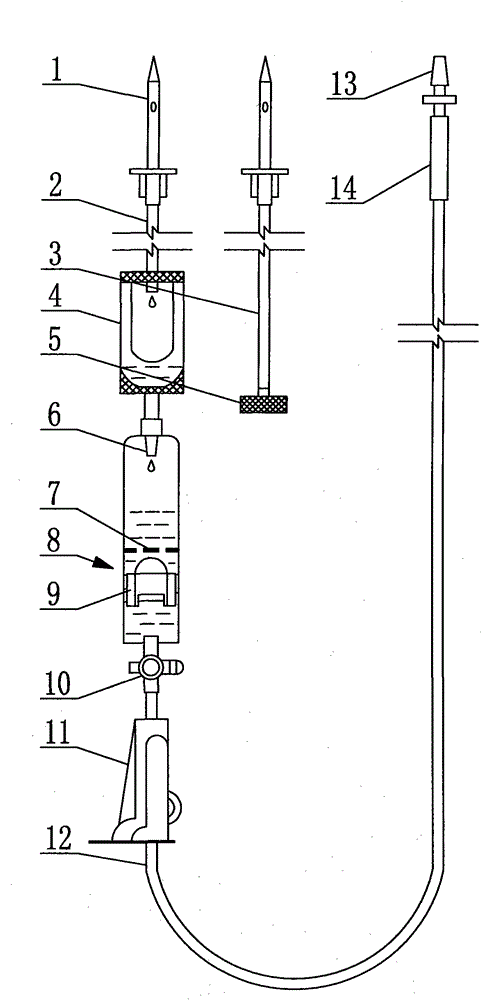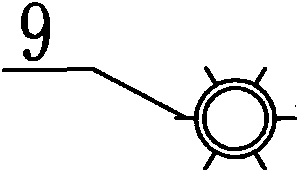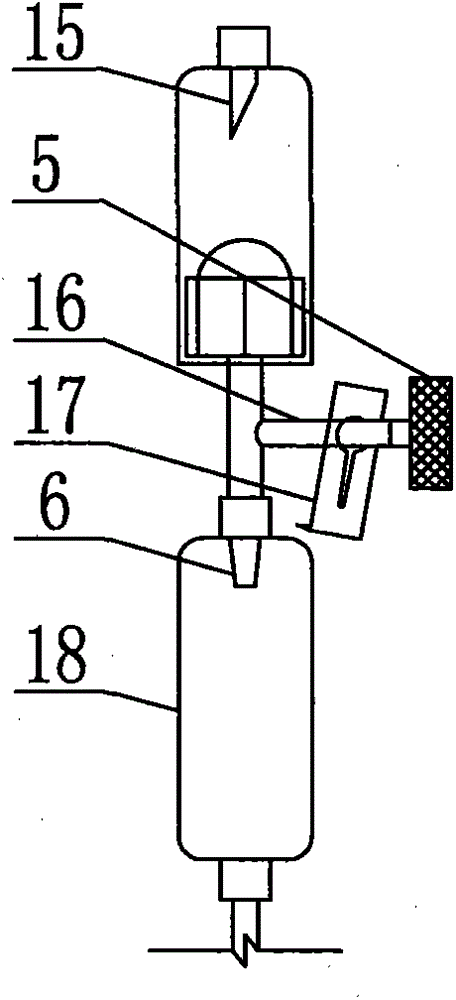The problems are: ①When the infusion tube enters a short section of air, the nurse often wraps the infusion tube around the fingers from bottom to top to
deflate the infusion tube and squeeze out the air in the infusion tube upwards. Sometimes it takes repeated operations to succeed, which takes a lot of effort Time-consuming and inconvenient; ②When the infusion tube enters a long section of air, the infusion needle must first be separated to
discharge stagnant liquid and air in the infusion tube, and then refill the infusion tube to continue infusion. and ward
pollution, and often affect the
curative effect and cause waste due to the
discharge of liquid, especially repeated
discharge (note: the symbol " / " in the present invention document refers to "or")
[0004] (2) Causes and discarding of stagnation in the infusion bag and blood transfusion set during
drip infusion In order to prevent the trouble caused by the air intake of the infusion tube, when the infusion bag is used for
drip infusion, most nurses, especially those in the
emergency department, deliberately do not Inserting the
airway will result in stagnation in the infusion bag, drip funnel, and the entire infusion tube. Nurses may pull out the needle with fluid or change to the next bag of fluid due to the patient's call, together with the stagnant fluid and residual fluid. Discard, according to the test, most of them are above or below 20ml
Especially for small infusion bags for precious liquids, the ratio of the residual liquid volume to the set infusion volume is relatively large, which is an unacceptable but inconvenient problem to deal with
[0005] (3) Blood return during
drip infusion and drainage and re-puncture after blood coagulation liquid path is blocked. Because the air intake of the infusion tube will shorten the
liquid column and reduce the pressure, or when the patient changes the position and causes the
venous pressure to fluctuate, it often occurs. Blood return phenomenon, even if there is a small amount of blood return in the infusion needle, if it is not found in time to refill the blood, it will often
cause blockage of the blood coagulation liquid path, and it is necessary to drain, exhaust, fill and puncture again, which is not only troublesome to operate, but also increases the patient's pain and cause waste
[0006] (4) Causes and discarding of the residual liquid in the infusion bottle during or at the end of the drip infusion. Since the liquid inlet of the bottle connector is located at its tip, residual liquid will be generated at the neck and mouth of the infusion bottle. The amount of residual liquid is mostly around 2 ml, especially the precious residual liquid is often ignored (for example: the
current price of a 50 ml bottle of
albumin injection is 600 yuan, if 1 ml remains, the direct loss is 12 yuan), the current infusion After the infusion stop of the bottle or at the end of the day’s infusion [referring to the period from the end of the last infusion bottle on the day to the end of the infusion, the following (including the claims) will not be re-released] together with the infusion bottle and its cavity The residual liquid is discarded together, and most nurses will feel distressed, but there is no way to deal with it
[0010] 2. Related Technical Defects
[0011] The defect of anti-liquid residual type infusion set (patent number: ZL00239693.9, announcement date: September 26, 2001) is: 1. the infusion bottle cavity of precious liquid cannot be rinsed and dripped into the
human body (hereinafter referred to as the infusion bottle cannot be rinsed). and drip into the human body); ②The
critically ill patients will continuously infuse more than ten bottles of liquid every day. Since the inlet and outlet of the drip funnel each have a
check valve, when the drip funnel drips the air into the infusion tube, even a short section of air It can't be drained upwards, and the method of separating the infusion needle can only be used to discharge the stagnant liquid and air in the infusion tube cavity; because the stagnant liquid is discharged or discharged multiple times, it will affect the
curative effect and cause waste, so it is not suitable for
continuous treatment.
Drip infusion; ③After the previous infusion bottle is empty, the air will enter the infusion tube to shorten the
liquid column and reduce the pressure, which often leads to blood return. Even if there is a little blood return in the infusion needle, the blood coagulation liquid path may be blocked, and the liquid must be re-drained , Exhaust, filling and
puncturing are not only troublesome, but also wasteful; ④ In the middle of winter, when the cold liquid enters the heating ward, the gas dissolved in the gap between water molecules is heated and expands (especially the liquid in the infusion tube is larger than that in the infusion bottle. The liquid is heated quickly) and precipitates to form air bubbles attached to the inner wall of the infusion tube. Due to the function of the
check valve, it is difficult to discharge them upward. Troublesome and wasteful; ⑤ Before infusion, insert the bottle connector of the infusion set into the inverted infusion bottle mouth, then close the infusion tube and squeeze the dripping funnel, squeeze the air in its cavity into the infusion bottle to make the infusion bottle Increase the pressure slightly to fill the infusion set and then perform the
venipunctureSince there is a
check valve on the liquid inlet of the drip funnel, it is difficult to squeeze the air in the drip funnel into the infusion bottle, which will affect the drip infusion operation (referring to the drip infusion preparation work)
[0012] Disposable multifunctional safety infusion set (patent number: 02280389.0, date of announcement: October 29, 2003) must be understood from the microscopic technology and feasibility: ① cannot rinse the bottle and drip it into the human body; ② sandstorm,
haze weather It has become a topic on the
tip of the tongue of the Chinese people today, but there is no
air purification component on the air guide tee 5 for adding
medicine. It is an exposed air guide port. After opening the cover, viruses, germs, dust, and small insects are suspended in the
atmosphere. There is a danger of entering the liquid circuit; ③ there is a check valve on the inlet and outlet of the drip funnel, and the problems caused by it are the same as the defects of the anti-liquid residual infusion set, so they will not be repeated; ④ (see the appendix of the manual) figure 1 , 7 , 12) The three-way port 5 of the
medicine-dosing gas guide is located above the dripping funnel, which will cause three problems: first, the cover can only be opened at the end of the day's infusion, otherwise it will cause the infusion tube to enter the air and affect the dripping funnel. Second, the nurse must wait for the liquid in the drip funnel and the upper section of the infusion tube to enter the human body naturally before further treatment, because some diseases (such as
heart failure) cannot be infused too quickly, that is, Using a
syringe to inject 5ml or 10ml of liquid medicine will also set a time. If the injection is too fast, it may cause problems. Third, it will take up and waste nurses’ time. Nurses are both angels and soldiers in white. Going to work is like fighting a war. Yes, doctors and patients must be on call without
delay or
delay, especially when many patients call at the same time, climate fusion, emergencies or natural disasters, nurses are often under great pressure; therefore, how to Convenience for nurses is beneficial to patients, and saving a little time for nurses is a problem that needs serious consideration; ⑤ From the design principle, the automatic closing valve device at the end of the infusion is reasonable, but it has passed through three factories for nearly a year The
model test of the
model test shows that the automatic closing valve device at the end of the infusion can not achieve the expected effect of closing the liquid circuit. The reason may be related to the slow downward speed of the liquid level during drip infusion and the long negative
pressure generation process (it relies on the slow down of the liquid level to generate negative pressure. ) low negative pressure value and (refer to the attached Figure 7 ) The cone-shaped float type automatic closing valve device at the end of infusion is related to the light weight of the float and the low pressure. In addition, compared with the original glass dripping funnel, the dripping funnel of the current infusion set is made of translucent soft material, which is slightly affected by negative pressure. The inward depression becomes deflated to offset part of the negative pressure, which in turn will reduce the negative pressure value and affect the closing effect; ⑥The automatic closing valve device at the end of the membrane infusion is located above the dripping funnel, and a relatively high negative pressure is generated instantaneously by squeezing the dripping funnel before infusion. The pressure will make the automatic closing valve device at the end of the membrane infusion in the
closed state, making it inconvenient to fill the infusion set, affecting the infusion operation, and becoming the six major factors for abandoning the patent right
Its defect is: 1. can not rinse the bottle and drop into the human body; The amount of residual liquid in a certain company’s product is about 8ml; ③After the previous infusion bottle is emptied, the air will enter the infusion tube, shortening the
liquid column and reducing the pressure, which may cause the risk of blood return and blockage of the liquid circuit, or the liquid must be re-drained, Exhaust, fill and puncture; According to three nurses from the Diabetes Department of Nanning Second People's Hospital, compared with traditional infusion sets, automatic exhaust infusion sets (such as products from Weihai Weigao, even if the dripping funnel is not empty) are more efficient. Blood return is prone to occur (mostly when the patient changes position), the reason may be related to the slight pressure relief effect of the exhaust port (like the exhaust port of the pressure
cooker cover); ④ anyway, the exhaust method is still open, It’s just that the opening part is different; because the exhaust port is located at the lower part of the infusion tube, when the patient’s wound oozes blood, pus overflows from the sore, incontinence, sneezing, blowing the
nose, coughing and
spitting,
choking on water,
nausea and
vomiting or When urinating and defecating on the
hospital bed, there is a risk of contaminating the liquid path through the exhaust port; as we all know,
bacteria, viruses and other microorganisms are everywhere and pervasive. Since the gas can be discharged from the exhaust port, pathogenic microorganisms such as
bacteria and viruses may also pass through the vent Intrusion, even if the probability is one in ten million, it should be avoided as much as possible. Once there is a problem, the doctors, patients, and the factory will be passive or cause tension, and incidents of murder of
medical staff due to a small problem happen from time to time; infusion After all, it is an input, and sealing is
safer than opening. Even catheterization and drainage will emphasize a problem of sealing, and it will not always be open; the "closed drainage" commonly used in
internal medicine and
surgery familiar to
medical staff "
Bottle" is enough to show how important airtightness is to safety; ⑤Whether the sweet and fishy smell (blood products) from the vent, especially the open vent, will attract mosquitoes, ants, fleas, etc. Time observation; ⑥When the exhaust port is not equipped with a sealing cover, it is easy to be misled by the word "automatic". Since the exhaust port is located at the lower part of the infusion tube, once the patient's limbs press the exhaust port to death, the air may enter the human body; When the air port is equipped with a sealing cover, the sealing cover must be opened to wait for the gas to be discharged naturally, and then cover it back. It is not only automatic, but also manual, which is not only troublesome, but also wastes nurses’ time
[0014] Patent No. 201120265273.0 has the disadvantages of the disposable non-exhaust continuous liquid infusion set: 1. the bottle cannot be rinsed and dripped into the human body; Small, there is a risk of blood return and blockage of the fluid path, which became the two main reasons for abandoning the patent right
Although the drip infusion principle of the infusion set and the blood transfusion set are similar, there are obvious differences in the structure, purpose, and method of use of the two, and they belong to different fields of appliances. Residual blood transfusion sets, based on the fact that there are many instruments with the same principle and different purposes, and the waste of blood transfusion is more prominent than infusion, in order to promote the solution of this problem, it is applied separately; ②Although no automatic hemostatic blood transfusion set has been found so far , but the float valve is an existing technology, or it may be considered easy to think of, so this application puts it in the
preamble of claim 1 and describes it
 Login to View More
Login to View More  Login to View More
Login to View More 


